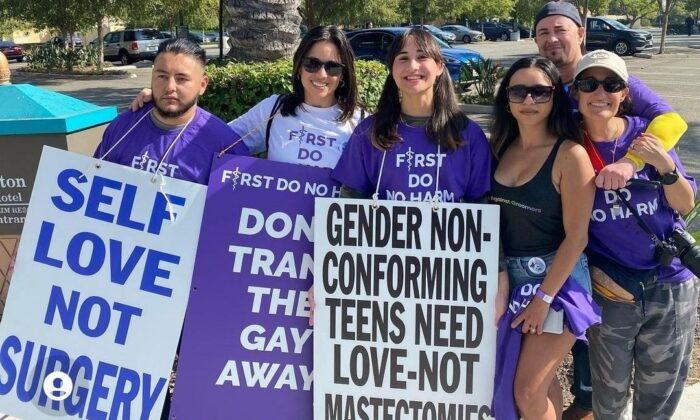Transgenderism has exploded among youth in the United States over the last decade.
The 2022 report also estimated that 3 percent of teens between the ages of 13 and 17 identify themselves as transgender, a 100 percent increase over the number in the organization’s 2017 report. The latest report used data from the U.S. Centers for Disease Control and Prevention’s 2017 and 2019 Behavior Risk Factor Surveillance System and the 2017–2020 Youth Risk Behavior Survey.
Dr. Michelle Cretella, an expert in adolescent sexuality, believes the rate is significantly higher than the Williams Institute report estimates.
“A rise this dramatic is most certainly due to indoctrination,” she told The Epoch Times.
Cretella is co-chair of the Adolescent Sexuality Committee of the American College of Pediatricians and serves as an adviser to the nonprofit organization Advocates Protecting Children.
For decades, the percentage of gender-confused youth remained mostly unchanged, she explained, adding the sharp increase coincides with the growth of social media apps and other media available to children.
“American society has been increasingly indoctrinating our youth into transgender beliefs since 2013 through all forms of media, including books for children and young adults, music, radio, TV, movies, internet, social media, and apps like TikTok,” Cretella said.
Researchers tracked clinic referrals of more than 5,200 young people up to the age of 18 from 2009 to 2016, according to the 2020 study published in the Journal of the American Medical Association.
In the UK, 4,684 patients were referred to GIDS for gender dysphoria over the study period. Of the patients referred, 2,837 were females, accounting for 60.6 percent of the referrals, and 1,847 were males.
In Australia, 558 patients were referred to RCHGS, of whom 308, or 55.2 percent, were females and 250 were males. The number of media items in the UK and Australia was 2,194 and 420, respectively.
Other Factors
In 2013, the American Psychiatric Association updated the 5th edition of the Diagnostic and Statistical Manual of Mental Disorders (DSM-5) in an attempt to normalize gender-confused individuals, according to Cretella (pdf).“The DSM-5 replaced Gender Identity Disorder with the category of Gender Dysphoria, and they argued that if these people are happy and socially functional with their false belief, they should be considered mentally well,” she said.
An increased suicide rate in transgender youth is also cited often in the media and the trans community as a reason to affirm such ideology.
But Cretella and other experts say the data quoted is skewed.
Oxford sociologist Michael Biggs, who studied suicide rates in children aged 10–19 years old in England, found transgender identity increases suicide risk by a factor of 13.
“The elevated risk, while concerning, is less than or within range of the suicide risk associated with other disorders,” Cretella explained. “Anorexia increases suicide risk by a factor of 18, depression multiplies one’s risk by a factor of 20, and autism raises suicide risk by a factor of 8.”
A Transgender Nightmare
Prisha Mosley’s transgender nightmare started when she was in treatment for multiple mental health conditions, including the eating disorder anorexia, depression, anxiety, and borderline personality disorder.“I had what’s called rapid onset gender dysphoria,” she explained to The Epoch Times. “I didn’t feel gender dysphoria until I was told I was born in the wrong body.”
Mosley, who was 15 when she began her social transition to a male, wants to bring awareness to the dangers—physical, mental, and emotional—of transgender ideology.
She said she was introduced to transgenderism when she was “deep in the trenches of the pro-ana community,” where young girls post “naked photos of their starving bodies and encourage each other not to eat.”
“And trans people go into that community—adults—and tell the children in that community that they are actually born in the wrong body,” Mosley said, adding that these children are told they can stop their anorexia by transitioning.

About a year before she began transitioning to a male, Mosley was raped. The assault resulted in a pregnancy that ended in miscarriage due to her eating disorder.
When Mosley told her parents she was transgender, they sent her to a therapist who quickly diagnosed her as trans and told them they must affirm their daughter’s beliefs or risk losing her to suicide.
“The rates of comorbidities in transpeople would blow your mind,” she said. “They all have suicidality, cluster B personalities, stuff like that,” she said. “So, they don’t have boundaries, and they need constant validation.”
Cluster B personality disorders are characterized by a tendency to be overly dramatic, overly emotional, or have unpredictable thinking and behavior, according to the Mayo Clinic.
Doctors who refused to affirm Mosley’s anorexic delusions were willing to affirm her trans ideology and encourage her to transition, she explained.
By the time she was 17, she was taking cross-sex hormones and, about a year later, had a double mastectomy, known as “top surgery” in the trans community.
Mosley eventually had a “breakthrough and clarity of mind” and returned to living as a woman. Now, she suffers from vaginal atrophy, facial hair, and other issues due to her medical and surgical transition. She also believes she will never be able to have children.
What Can Parents Do?
Erin Brewer, author and co-founder of Advocates Protecting Children, was a gender-confused kid before transgender ideology was prevalent in society. She has written several books including, “Common Sense Care, Parenting Gender-Confused Kids With Truth and Love,” and the children’s book, “Always Erin.”Brewer, who grew up in the mid-70s to 80s, was sexually assaulted by two men as a very young girl. The attack left her angry and aggressive.
She reasoned that the assault would not have happened if she had been a boy. So, when she started first grade, she decided to be a boy.
Luckily, her teachers recognized she needed help.
“My teachers were a godsend to me,” Brewer told The Epoch Times. “My family life was a mess. ... I had some tremendous teachers that really saved me because they were so kind and caring.”
Brewer said no one ever affirmed her gender confusion. Rather, she received therapy to address the trauma she had endured.
She fears if she was a child with those feelings today, she would have lost the opportunity to be a mother, which is why she advocates for parents to talk to their children about the topic.
“In the same way that you might [talk] to your child about stranger danger,” Brewer said. “Talk to your children about the fact that there are going to be people who try to confuse them and that those are people who don’t have their best interests at heart. Really, make it clear so that kids know to look out for this.”
Most children who are gender confused have other emotional or social issues that need to be addressed, according to Cretella.
“Hug your child and tell him or her that you love them unconditionally and will do whatever it takes to help them achieve optimal health,” she said, adding that “a sterilized and mutilated body is not optimal health.”





